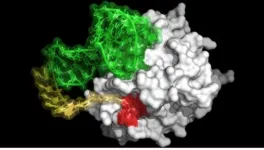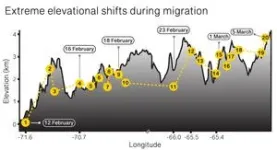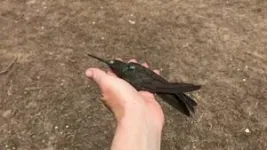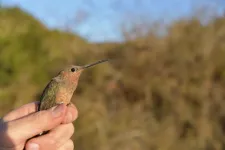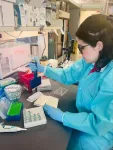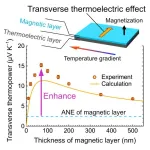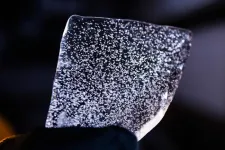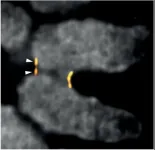(Press-News.org) DURHAM, N.C. – Nature gave ticks, mosquitos and leaches a quick-acting way to keep blood from clotting while they extract their meal from a host.
Now the key to that method has been harnessed by a team of Duke researchers as a potential anti-clotting agent that could be used as an alternative to heparin during angioplasty, dialysis care, surgeries and other procedures.
Publishing in the journal Nature Communications, the researchers describe a synthetic molecule that mimics the effects of compounds in the saliva of blood-sucking critters. Importantly, the new molecule can also be swiftly reversed, enabling clotting to resume when needed after treatment.
“Biology and evolution figured out anti-coagulation multiple times with a highly potent strategy,” said senior author Bruce Sullenger, Ph.D., professor in the departments of Surgery, Cell Biology, Neurosurgery and Pharmacology & Cancer Biology at Duke University School of Medicine. “It’s the perfect model.”
Sullenger and colleagues at Duke and the University of Pennsylvania -- including lead author Haixiang Yu, Ph.D., a member of Sullenger’s lab -- started from the observation that all blood-sucking organisms evolved a similar system to inhibit blood clotting. The anti-clotting agent in their saliva uses a two-pronged process, binding to the surface of certain clotting proteins in the host’s blood, and entering into the protein’s core to temporarily inactivate clotting during a blood meal.
Blood-sucking organisms target different proteins among the sequence of more than two dozen molecules involved in clotting, but the research team concentrated on engineering molecules to home in on thrombin and factor Xa in human blood, achieving the dual-action anti-clotting function against these proteins.
The next challenge was devising a way to reverse the process -- essential for clinical applications to ensure that people don’t hemorrhage. With the activation mechanism fully elucidated, the researchers were able to reverse engineer an antidote that quickly restores clotting.
“We believe this approach could be safer for patients and generate less inflammation, as well,” Yu said.
Another plus is that it is a synthetic molecule, unlike the current clinical standard for the past 100 years, heparin. Heparin is isolated from pig intestines, requiring a massive farming infrastructure that generates pollution and greenhouse gases.
“This is part of a new passion of mine – improving agents that control blood clotting to help patients, while also being responsible from a climate perspective,” Sullenger said. “The medical field is starting to recognize that there’s a big problem here, and we need to find alternatives to using animals for making medicines.”
In addition to Sullenger and Yu, study authors include Shekhar Kumar, James W. Frederiksen, Vladimir N. Kolyadko, George Pitoc, Juliana Layzer, Amy Yan, Rachel Rempel, Samuel Francis, and Sriram Krishnaswamy.
The study received funding support from the National Institutes of Health (P01-HL139420, 23POST1018721). Duke has submitted a patent application on the thrombin and factor Xa EXACT inhibitors; Sullenger and Yu are listed as inventors.
END
New molecule mimics the anti-clotting action of blood-sucking organisms
The anti-coagulant shows potential as an environmentally friendly alternative to heparin
2024-05-13
ELSE PRESS RELEASES FROM THIS DATE:
Transgender preteens report 13 hours of daily screen time
2024-05-13
Toronto, ON - A new national study found that transgender preteens, 12 and13 years old, reported 13 hours of daily recreational screen time, which was 4.5 hours more than their cisgender peers. Data were collected from 2019 to 2021, overlapping with the COVID-19 pandemic, and the study was published in Annals of Epidemiology.
“Transgender adolescents are more likely to experience school-based bullying and exclusion from peer groups due to their gender identity, leading them to spend less time in traditional school activities and more time on screens,” says lead author, Jason Nagata, MD, associate professor of pediatrics at the University of California, San Francisco. ...
World's largest hummingbird is actually two species
2024-05-13
For release: May 13, 2024
Ithaca, NY—The Giant Hummingbird of western South America is not one species but two, according to an international group of researchers. The northern population stays in the high Andes year-round while the southern population migrates from sea level up to 14,000 feet for the nonbreeding months. The two species appear identical. But looks deceive—their genomes and behaviors tell a different story. The paper announcing the find was published this week in the journal Proceedings of the National Academy of Sciences.
“These ...
New findings released from US 2020 Facebook and Instagram election study
2024-05-13
In the weeks before and after the 2020 presidential election, researchers ran a number of tests to try to understand how much Facebook and its corporate cousin, Instagram, may be contributing to the nation's political divide.
One of those experiments — led by Matthew Gentzkow and Hunt Allcott, economics professors at Stanford University — centered on more than 35,000 Facebook and Instagram users who were paid to stay off the platforms in the run-up to Election Day. There’s a lot that researchers could glean from the social media hiatus, including whether people’s political attitudes shifted and in what ways. If views changed dramatically, that ...
How miniature backpacks led to the discovery of the world’s largest hummingbird species
2024-05-13
Researchers from UNM’s Museum of Southwestern Biology (MSB) have uncovered the giant hummingbird’s extreme long-distance migration for the first time. Their eight-year study, Extreme elevational migration spurred cryptic speciation in giant hummingbirds published this week in Proceedings of the National Academy of Sciences, led them to another important discovery: The world’s largest hummingbird is a new species.
The team, led by Jessie Williamson, UNM Ph.D., 2022, included the Museum of Southwestern Biology at UNM, Pontificia Universidad Católica de Chile in Chile, and Centro de Ornitología ...
New synthetic biomarker technology differentiates between prior Zika and dengue infections
2024-05-13
A newly discovered Zika virus-specific synthetic molecule is capable of differentiating Zika-immune patient samples from samples of patients previously infected with the related dengue virus. The technology may lead to the development of better diagnostics and vaccine candidates, scientists announced today in the Proceedings of the National Academy of Sciences.
The study, led by researchers at the University of Pittsburgh School of Public Health and The Herbert Wertheim UF Scripps Institute for Biomedical Innovation & Technology, is the first to apply an innovative “epitope surrogate” technology to Zika. Until now, researchers and clinicians have lacked diagnostic ...
Fruit fly testes offer potential tool against harmful insects
2024-05-13
A way to curb nagging insects has been flying under our radar—an enzyme from fruit fly testes.
The compound could control bugs that carry disease and harm crops by stunting their ability to procreate, Johns Hopkins University researchers found.
“We have a toe in the door to control fruit fly populations with this enzyme,” said Steven Rokita, a professor of chemistry at Johns Hopkins who led the research. “It could offer a good way to control fertility of all kinds of biological and agricultural pests, starting with mosquito populations.”
The findings are set to publish ...
Exceptionally large transverse thermoelectric effect produced by combining thermoelectric and magnetic materials
2024-05-13
1. A NIMS research team has demonstrated for the first time ever that a simple stack of thermoelectric and magnetic material layers can exhibit a substantially larger transverse thermoelectric effect—energy conversion between electric and heat currents that flow orthogonally to each other within it—than existing magnetic materials capable of exhibiting the anomalous Nernst effect. This mechanism may be used to develop new types of thermoelectric devices useful in energy harvesting and heat flux sensing.
2. Seebeck effect-based ...
Researchers identify fastest rate of natural carbon dioxide rise over the last 50,000 years
2024-05-13
CORVALLIS, Ore. – Today’s rate of atmospheric carbon dioxide increase is 10 times faster than at any other point in the past 50,000 years, researchers have found through a detailed chemical analysis of ancient Antarctic ice.
The findings, just published in the Proceedings of the National Academy of Sciences, provide important new understanding of abrupt climate change periods in Earth’s past and offer new insight into the potential impacts of climate change today.
“Studying the ...
Research on centromere structure yields new insights into the mechanisms of chromosome segregation errors
2024-05-13
Researchers from the Kops group in collaboration with researchers from the University of Edinburgh, made a surprising new discovery in the structure of the centromere, a structure that is involved in ensuring that chromosomes are segregated properly when a cell divides. Mistakes in chromosome segregation can lead to cell death and cancer development. The researchers discovered that the centromere consists of two subdomains. This fundamental finding has important implications for the process of chromosome segregation and provides new mechanisms underlying erroneous divisions in cancer cells. The research was published in Cell on May 13th 2024.
Our bodies consist of trillions of ...
Ochsner Medical Center-Baton Rouge earns Acute Stroke Ready Certification from Joint Commission
2024-05-13
BATON ROUGE, La. – Ochsner Medical Center - Baton Rouge has earned The Joint Commission’s Gold Seal of Approval® and the American Stroke Association’s Heart-Check mark for Acute Stroke Ready Certification.
The designation means OMC-Baton Rouge meets The Joint Commission's designation for readiness to treat patients who experience severe stroke.
To achieve certification, OMC-Baton Rouge underwent a rigorous, unannounced onsite. During the visit, a team of Joint Commission reviewers evaluated compliance with numerous certification standards, including ...
LAST 30 PRESS RELEASES:
Numbers in our sights affect how we perceive space
SIMJ announces global collaborative book project in commemoration of its 75th anniversary
Air pollution exposure and birth weight
Obstructive sleep apnea risk and mental health conditions among older adults
How talking slows eye movements behind the wheel
The Ceramic Society of Japan’s Oxoate Ceramics Research Association launches new international book project
Heart-brain connection: international study reveals the role of the vagus nerve in keeping the heart young
Researchers identify Rb1 as a predictive biomarker for a new therapeutic strategy in some breast cancers
Survey reveals ethical gaps slowing AI adoption in pediatric surgery
Stimulant ADHD medications work differently than thought
AI overestimates how smart people are, according to HSE economists
HSE researchers create genome-wide map of quadruplexes
Scientists boost cell "powerhouses" to burn more calories
Automatic label checking: The missing step in making reliable medical AI
Low daily alcohol intake linked to 50% heightened mouth cancer risk in India
American Meteorological Society announces Rick Spinrad as 2026 President-Elect
Biomass-based carbon capture spotlighted in newly released global climate webinar recording
Illuminating invisible nano pollutants: advanced bioimaging tracks the full journey of emerging nanoscale contaminants in living systems
How does age affect recovery from spinal cord injury?
Novel AI tool offers prognosis for patients with head and neck cancer
Fathers’ microplastic exposure tied to their children’s metabolic problems
Research validates laboratory model for studying high-grade serous ovarian cancer
SIR 2026 delivers transformative breakthroughs in minimally invasive medicine to improve patient care
Stem Cell Reports most downloaded papers of 2025 highlight the breadth and impact of stem cell research
Oxford-led study estimates NHS spends around 3% of its primary and secondary care budget on the health impacts of heat and cold in England
A researcher’s long quest leads to a smart composite breakthrough
Urban wild bees act as “microbial sensors” of city health.
New study finds where you live affects recovery after a hip fracture
Forecasting the impact of fully automated vehicle adoption on US road traffic injuries
Alcohol-related hospitalizations from 2016 to 2022
[Press-News.org] New molecule mimics the anti-clotting action of blood-sucking organismsThe anti-coagulant shows potential as an environmentally friendly alternative to heparin
